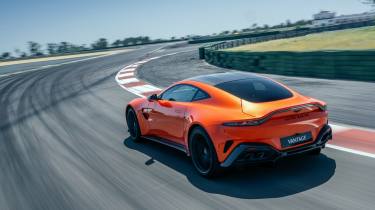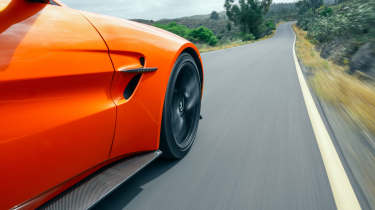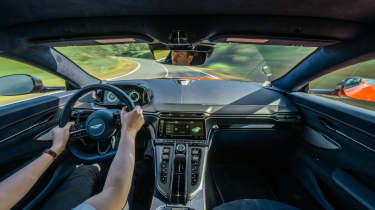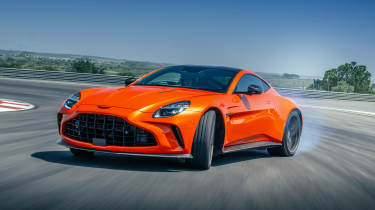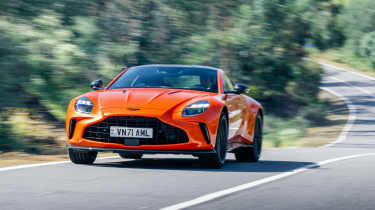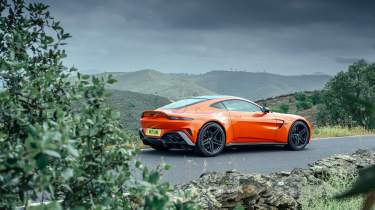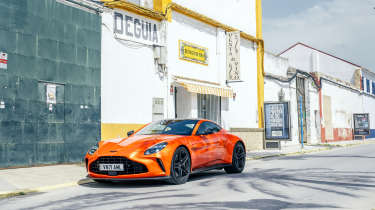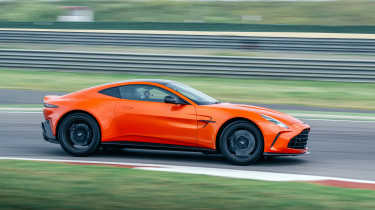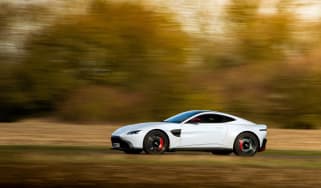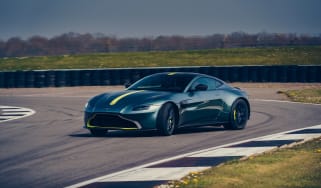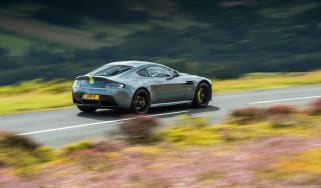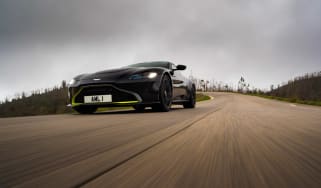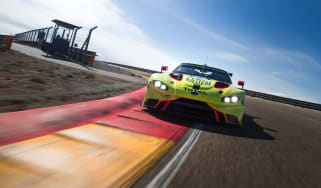Aston Martin Vantage 2024 review – the best Aston in years
The junior Aston Martin has been thoroughly reengineered. It’s not so junior any more
There are some big numbers associated with the new Aston Martin Vantage. Really big. 656bhp. 590lb ft. 202mph. And a £165,000 entry price, taking this once-junior Aston into thoroughly senior territory.
Two days with the new Vantage on both road and track have shown us this is anything but a by-the-numbers facelifted car, however. This is a thoroughly engaging, well-resolved car that’s not only a big step on from the older Vantage but a great car in its own right. Before we drive it, here’s a quick recap of exactly what’s changed versus the original 2018-on Vantage this renewed model supersedes.
> Aston Martin DB12 Volante 2024 review – Britain’s Ferrari beater?
Design
While the rear lights and the bodyshell’s essential shape and hard points remain the same, practically every panel has changed. One of the first things your eye is drawn to is the pair of new, larger, headlights, which help to visually balance the new, frankly gigantic, grille. There’s a lot of it, because the muscled-up powertrain demands so much cooling performance. New cooling gills either side mildly echo the old Aston Martin One-77, and balance the new car’s extra width: it’s a full 30mm wider than before. The wider track is emphasised by the new visible side skirt, balanced nicely by the redesigned side strake.
Powertrain and drivetrain
The 656bhp power output (153bhp more than the old Vantage, and 129bhp more than the more powerful F1 Edition) is a statement. It helps position the new Vantage over the likes of the new AMG GT and Porsche 911 Turbo S and helps to justify its new price point.
More reviews
The turbos, heads, cams, inlets, exhausts – the block, even – are new compared with the previous Vantage. ‘We effectively had free reign to select what we wanted from AMG,’ explains director of vehicle performance Simon Newton.
The ZF eight-speed gearbox remains, with redesigned elements of the transmission and software tweaks for a faster shift than before. Ratios are the same as before, but a five per cent shorter final drive gives more urgent acceleration. As before, there’s an electronically-controlled locking differential, recalibrated on the new car to fit in with Bosch’s latest ‘feed-forward’ dynamics system.
Interior
The interior has been even more comprehensively overhauled. It’s more modern, more attractive, higher-quality in feel and with a vastly more up-to-date media and screen interface; the same system as in the DB12 and now the updated DBX, too.
Happily, there are still physical switches (but much more attractively laid out than before), with tactile, textured rollers for stereo volume and air-con fan and temperatures for driver and passenger. ‘The industry is reaching “peak screen,” Simon Newton acknowledges, ‘so we’ve designed the interface so that you can drive it on the switches too.’ There are buttons too to toggle modes for the adaptive dampers and active exhausts, and you put the car into drive via a traditional selector now, rather than the old separate P, N, D and R buttons.
This has helped tidy the dashboard up, and a smart horizontal trim line runs through the middle of the dash. In this car it’s black carbonfibre, but you can choose all kinds of coloured finishes or Alcantara. In fact, there are seemingly limitless options for personalisation.
Though much of the cabin is new, the spacing between wheel, hip point and pedals is the same as before, and you settle into a true, low-set, arms-and-feet-ahead front-engined sports car driving position.
Structure
Aston Martin has gone to great lengths to stiffen the Vantage’s structure at strategic points, and to increase torsional stiffness across the chassis as a whole. For example, the rear damper tops are linked together in the area behind the driver’s seat, there are additional sheer panels front and rear, and there is a new engine cross mount design.
Aside from giving Aston Martin’s engineers greater flexibility of tyre and damper choice, the goal is greater precision; the added stiffness across the rear of the car affects the lateral load across the rear tyres, and their reaction too.
Suspension, steering, brakes and tyres
A further goal of the front stiffening measures is to achieve better on-centre steering feel (‘Often difficult to get with a sporty tyre,’ Newton says; and the Vantage now wears decidedly sporty Michelin Pilot Sport 5 S tyres, in a bespoke specification for the car with Aston Martin markings. They’re 21 inches in diameter, up an inch from before. In fact they’re the same 275 front/325 rear size as the DB12, but different tyres). All wheel options are now forged.
The electric power steering has been retuned, and the steering column re-engineered for better feel and response. Springs, bars, and bushes have all been revisited. The wider track enhances performance, too. The new dampers are electronically controlled Bilstein DTX dampers: ‘a big investment for us,’ Newton says.
Brakes have increased in size, to 410mm discs at the front (with six-piston calipers). Rears are 360mm, with four-piston calipers. A new brake servo system gives a stiffer, more communicative pedal response, and Aston Martin has engineered separate servos depending on whether customers choose the standard cast-iron brakes or optional ceramics (which are fitted to the cars we’ll drive here), for the best possible feel.
Despite the attention-grabbing numbers, there’s been just as much toil spent over making the new Vantage fun and engaging at regular road speeds as there has been on reaching numerical performance metrics. ‘This is the most agile, precise, dynamic, enjoyable sports car we’ve ever done,’ head of product strategy Alex Long says. ‘In benchmarking, you find a lot of cars don’t come alive until you’re going really quick,’ Newton adds. ‘Dexterity and feedback at low speed, too, have been key for this car.’
You sense that Aston Martin’s engineering team has been given the freedom, and budget, to make this renewed Vantage the very best it can be. Now, for the proof of the pudding.
New Aston Martin Vantage road test
The Mercedes-sourced 4-litre twin-turbo engine growls into a muscle-car-esque wub-wub-wub at idle but it’s a smooth, docile powertrain at town speeds. As on the Vantage’s larger DB12 sibling, the transmission is desperate to get into a high gear as early as possible and you swiftly find yourself changing gear yourself with the shift paddles (which have been relocated from the steering column to the back of the steering wheel itself) to keep it in a lower gear for roundabouts and slip roads. Before too long, you might even find yourself locking the transmission in manual, using the button located behind the gear selector (in a position that’s a bit of an awkward stretch while driving). But the gearbox is swift, and smooth. In the racier driving modes, gear changes are conducted with a more emphatic thump that you sense is partly for effect, but it’s not an uncomfortable sensation.
Trickling through narrow, unsighted rural roads west of Seville, the base for the new Vantage’s launch, it does feel a wide car. Although overall width between the mirrors (suspended on neat, blade-like armatures) is the same as the previous car, its 30mm-broader body occupies more road than before. But, unlike the DB12 which, for me, takes a little time to feel at ease with, the Vantage psychologically shrinks around you much more quickly. It’s a wieldy car, and – crucially – the feel and feedback through the steering wheel, and the wheels and chassis themselves, is full of clarity.
There are five driving modes, selected by turning the collar which surrounds the starter button. Sport is the default mode (it’s called GT in the DB12, summarising the difference in ethos between the two products), then there’s Sport +, Track, Individual for mixing and matching settings, and a new Wet mode.
There’s also a variable traction control system, which uses the same collar to click between nine settings: 1 being maximum traction, 5 being in the middle, 8 allowing a great deal of movement, and 9 being all the way off.
In the firmer Sport + mode, the suspension is really quite firm. In fact, on first acquaintance, it feels really quite firm in default Sport mode, too. There are some very rough roads as we head further into the hills – pockmarked and potholed enough to rival UK tarmac, in fact – and the Vantage’s low-speed ride on rough surfaces and secondary ride at a cruise is rather more fractious than you might expect from its suave appearance. It’s noticeable both as a driver and a passenger.
It gets better with speed, however: the quicker you go, the more lithe and supple the Vantage becomes. As the roads climb into remote hills, they become all but deserted, bar the scudding shadows of birds of prey wheeling above. The tarmac here is smoother too, and as we up our pace, I find myself clicking the Drive mode dial to Sport +, to firm the dampers up slightly and further tighten the Vantage’s already deft body control. Tackling these roads’ long, well-sighted bends at speed you feel the car settle and squat slightly in the first phase of the corner, before adopting a stable pose. A controllable one, too. Front-end grip is mighty, and the rear follows beautifully. If space, vision and desire allow, you can also steer the car on the throttle – something we’ll explore more on the circuit shortly.
I’d worried that the new, gargantuan power output might actually be the undoing of the Vantage rather than the making of it. Not because it would make it a wild animal to drive, but because I wondered if Aston might need to limit its torque delivery to keep the car tamed. Driving the Aston Martin DB12 Volante recently (in admittedly un-grippy weather conditions), it often felt as if its slightly bigger power and identical torque output to the Vantage were being electronically damped-down; it was rarely possible to feel the engine’s full sweep of performance unless you turned off the traction control; something you might not always wish to do on the road. And a less powerful car that you can truly extend on the road is often more fun than one that can’t be fully uncorked.
The Vantage is different from the DB12. Despite its huge power output, it’s a malleable car to drive. With such clear communication, you can feel what’s going on with the contact patches of the new Pilot Sport S 5 tyres in detail, and strong mechanical traction means that, very often, you really can put all that torque down to the road. (That road in this case, admittedly, being smooth, sun-baked Spanish tarmac.)
The new touchscreen, as on the DB12, can be a bit of a faff to operate, unfortunately. Although it’s attractive, the text is optician-eye-test tiny, and it was a little laggy in our test car. That said, updates over time will keep it up to date and it will doubtless improve. And it still feels like a step on from the system in the older Vantage.
You can ramp up the exhaust’s volume and allow more V8 bombast into the cabin by three stages, via a button on the centre console, but even in its quieter mode this is still a pretty noisy car. To the point, in fact, where the engine’s volume can become a bit tiring at a cruise. Sounds fantastic from the outside, though: a Vantage drive-by sounds like a Spitfire flying past at low altitude.
New Aston Martin Vantage Track Test
At the Monteblanco race track we switch into an identical Vantage albeit with the optional carbonfibre sports seats, which look stunning. (Although I’ll find that, like the regular seats, they don’t quite support my upper body as firmly as their bucketed shape suggests.)
Ordinarily track time is limited to a handful of supervised laps on a car launch, but Aston Martin gives us freedom to carry out almost as many laps and cornering shots in the Vantage as we like, which says a lot for its faith in the car. Especially as Monteblanco is a relatively punishing track with big braking areas and a mixture of tyre-torturing low-speed corners and big-speed, big-momentum high-speed sections.
You can leave your braking last-gasp late from 160mph or so for tight Turn One and both stopping power and pedal feel are superb. After a few quick laps, however, the brakes do start to fade. This is a road car after all, however. Although it’s not an ultra-heavy car, nor is it a super-light one; Aston Martin quotes a dry weight of 1605kg, and a ‘wet’ weight is not made available.
As on the road, one of its most impressive traits is its balance. The adjustable traction control’s default setting is five out of eight: a mode that’s very safe on this dry track. Six allows a good deal of movement, seven even allows big slides and eight is hilarious: you can achieve ridiculous angles yet still recover the car smoothly. The ‘feed-forward’ dynamic software, which integrates multiple sensors and accelerometers with the ABS, e-diff and so on to predict the driver’s intentions before actuating a response helps the stability control to be subtle in the way it intervenes. So subtle, in fact, that you can quickly fool yourself into thinking you’re doing all the work yourself: it’s immensely flattering.
Switching everything off demonstrates this. Suddenly, you need much faster hands and more alert reflexes to catch and hold the Vantage in a slide. And yet: it’s still brilliant. Without the electronic safety net, the car’s feedback, control and well-resolved set-up make it a really intuitive car to control. Aside from being introduced into a slide in a precise way, unusually, it can be straightened up in an impressively controllable way too. It’s anything but snappy.
And if 656bhp might seem like overkill on paper, it makes the Vantage a fantastic plaything here. Peak torque spread broadly all the way from 2750rpm to 6000 is a big part of the car’s performance, too. But it feels more like a precision tool than a sledgehammer.
Not all cars are as intuitive as this to manipulate at and beyond the limit, and, a little mild brake fade aside, the Vantage’s stamina is impressive. Behind all those square inches of grille surface there are twin stack coolers, the better for track work. Aston Martin says that the Vantage can sustain the same performance on track as the previous car in 10degC higher ambient temperatures.
Price and rivals
The power, torque and top speed figures give the new Vantage the headline stats it needs to justify its positioning at a higher price point, starting at £165,000. Whether it’s a better one than its rivals will have to wait for the group test, but it is a truly compelling alternative to the likes of the new Mercedes-AMG GT 63 (which sits at a similar price point) and the Porsche 911 Turbo S (which is more expensive and blends explosive performance with continent-crossing comfort, but perhaps a little less character than the evocative Aston). Ferrari’s brilliant Roma is a more expensive car still, though the Vantage is now closer in price than before and has the performance figures to compete on paper.
But the new Vantage is more than a Top Trumps card on wheels. Subjectively and objectively, this is a truly fun car, and a desirable one, which you might choose on its own merits rather than judge it against competition.
The new Vantage is about feel, feedback and carefully resolved details, and it’s one of the most dynamically rewarding Aston Martins yet.
2024 Aston Martin Vantage specs
| Engine | V8, 3982cc, twin-turbo |
| Power | 656bhp @ 6000rpm |
| Torque | 590lb ft @ 2750 – 6000rpm |
| Weight | 1605kg (dry) |
| Power-to-weight | 415bhp/ton (dry) |
| Tyres as tested | Michelin Pilot Sport S 5 |
| 0-62mph | 3.5sec |
| Top speed | 202mph |
| Basic price | £165,000 |

